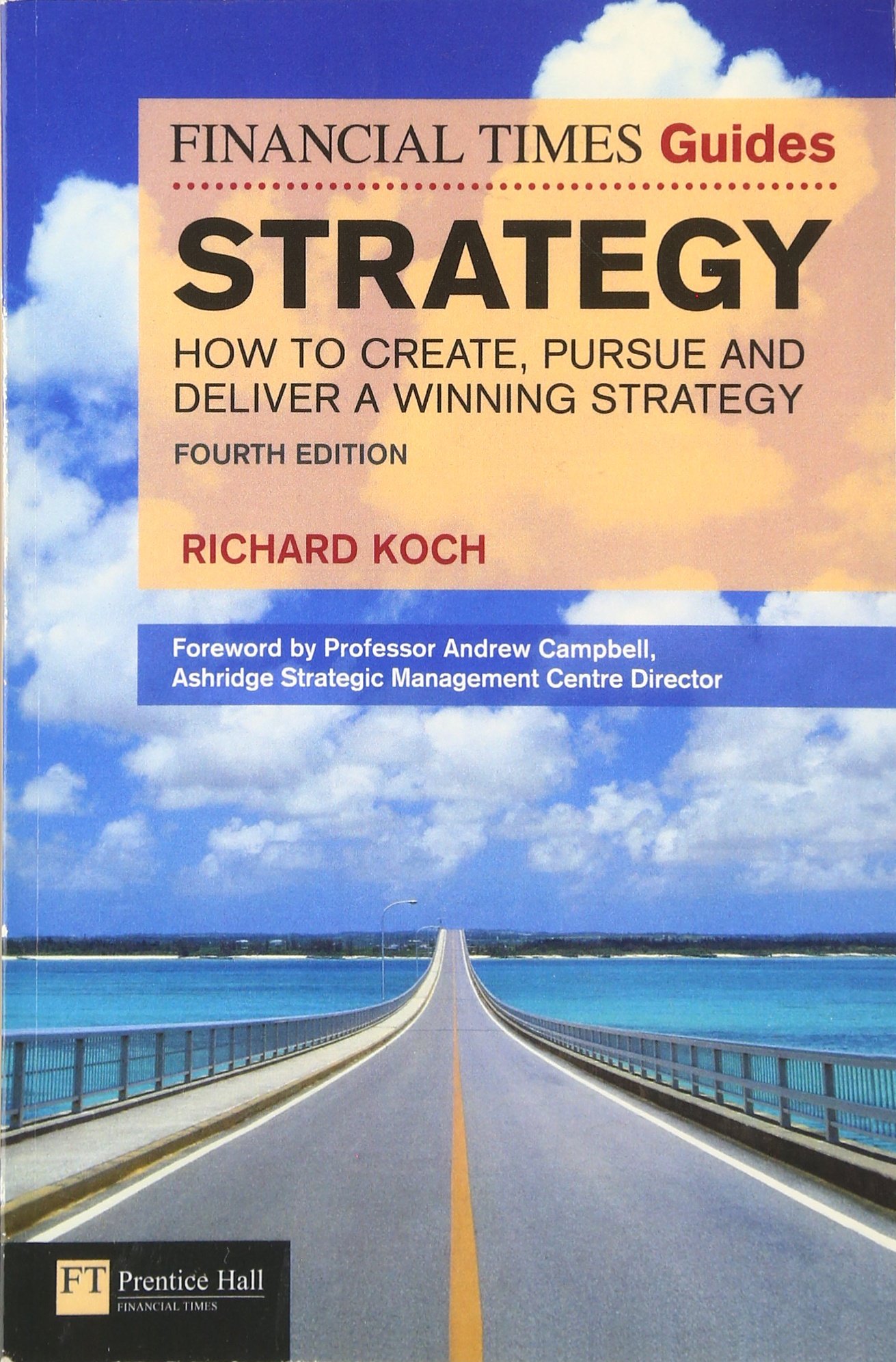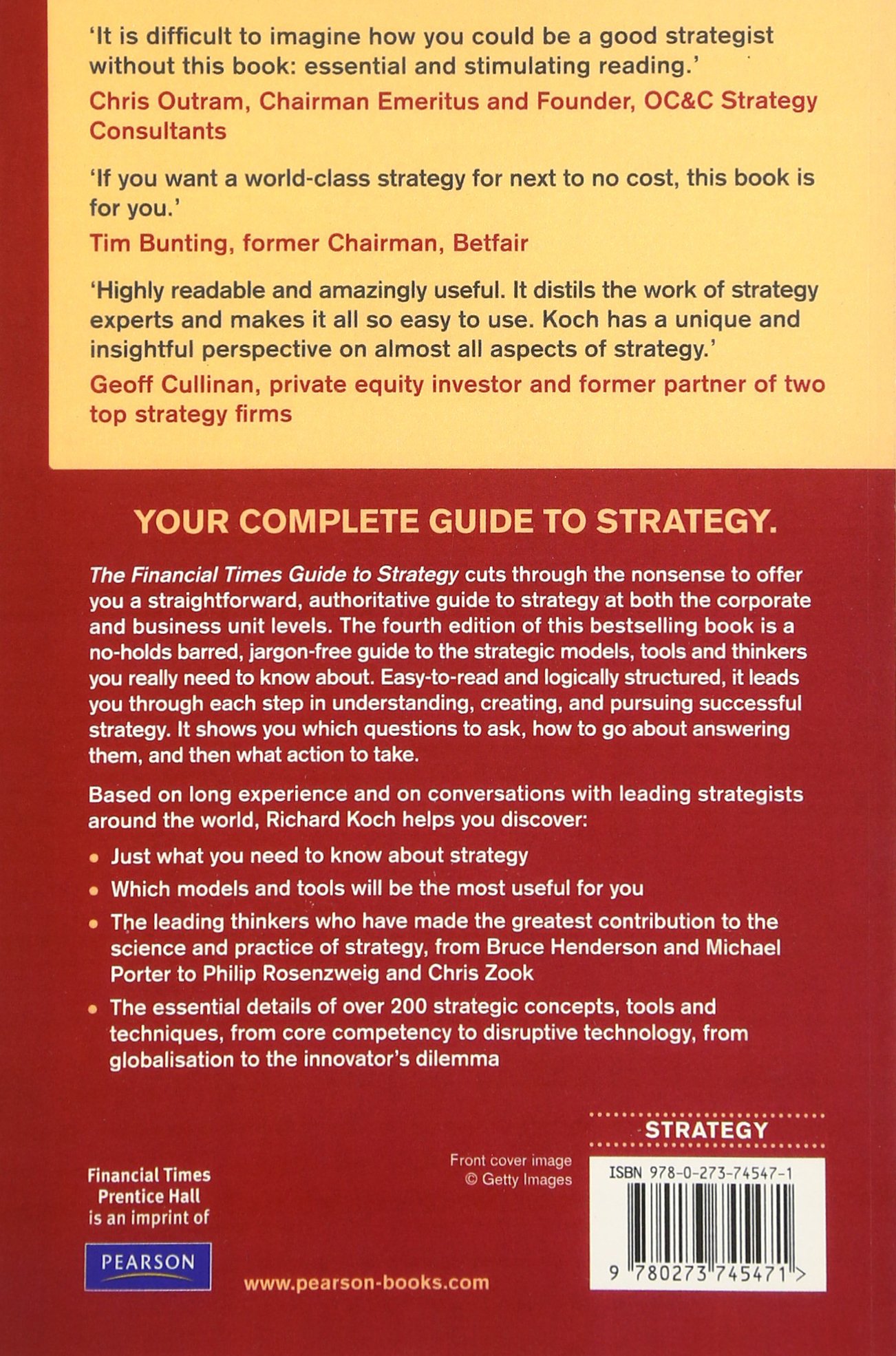Customer Services
Copyright © 2025 Desertcart Holdings Limited
Desert Online General Trading LLC
Dubai, United Arab Emirates




Full description not available
J**Y
Text book
This was a text book used in obtaining my degree
D**S
Five Stars
Great read, concepts and ideas which I've begun to apply with success. Highly recommended.
A**R
Four Stars
does Amazon read that book?
D**A
The Business Strategy Foundation Book
After reading Koch's "80/20 Principle", I was convinced that he's a mind of his own. His non-conform thinking and writing is extraordinary. Had I only read this book on Strategy before entering my MBA, business school life would have been much easier. Koch's book on strategy is a foundation book, covering the crucial basics for "understanding" business strategy (roughly 80%). It helps espcially the student of strategy not to get (too) confused by providing basic understanding what business stratetgy is all about. The chapters:INTRODUCTION Koch states wonderfully the use and abuse of strategy and the swings in strategic thinking.BUSINESS UNIT STRATEGY A do-it-yourself guide with excellent examples.CORPORATE STRATEGY Very critical Mr Koch argues about the value creation of corporate strategy.STRATEGIC THINKERS A guide to some of the most useful and important 40 strategic thinkers and their ideas.STRATEGIC CONCEPTS, TOOLS AND TECHNIQUES An A-Z glossary. The key words (or rather Consulting & MBA buzzwords)used in the world of strategy.STRATEGIC SHIFTS IN THE 21 CENTURY Forward lookin Koch claims that the tools of strategy are particular valuable for understanding and exploiting shifts of increasing returns, networks, and the net in our new century.
B**A
Four Stars
On point
I**N
The sad fact is that strategy development is rarely done by ...
The sad fact is that strategy development is rarely done by the right people,” Koch asserts.The first part of the book is a useful way to begin using strategy in your business. All too often managers who are running clearly defined businesses or business units never get to grips with strategy insights.In many businesses or discrete business units in corporations, where strategy is used to improve the business, it is developed by two groups of people. One group of people draw up a plan, making recommendations and may even do the monitoring. The implementation is done by another group of people. This rarely works, primarily because those who are supposed to be pursuing the new strategy, don’t understand what went into developing it, or don’t believe it, or don’t have the authority and confidence to adapt it to the changing circumstances of commercial life.There are many approaches to strategy, and like any other discipline, it has evolved and developed.Many people still think of strategy as the answer to where we are now and where we wish to be in the future, and how to get there. Once you have answered these questions, you have a strategy plan. This presumes that there is no competition, that getting your company to follow the plan will happen because you put it in writing - when your company isn’t even able to deliver their goods on time.The beginning of developing a strategy, as describe by Koch, is a blend of understanding the profitability of your business currently, and understanding your competitive environment. This is undoubtedly a useful starting point but requires that the managers get involved in doing most of the work. They will also get to see that strategy is not an inaccessible activity, only capable of being performed by highly trained outsiders.It will also alert the participants to the fact that businesses generally don’t develop their strategies scientifically and rigorously. It involves a great deal of intuition and creativity. However, it also involves a significant amount of effort.The quickest and most reliable way to get a realistic view of the business, is to do a detailed analysis of profitability by customer segment and product. Most businesses can be described as an island of profitability in a sea of red ink – few areas of profit making and a hoard of loss-making units. It is an important first step because money does not lie.Business success requires that companies focus where the money is in the short-term and long term. This entails the answer to two questions: are we in an industry that is worth staying in, and how can we do better than we are.One determines how much the race is worth and the other, whether you win the race.Industry attractiveness, on average, explains about 30% of the difference in a business’s profitability. The business’s competitive position within the industry, their management, skills and culture, explain about 70% of their success.A good industry to be in will give most of the businesses in the industry high returns on capital, and these will either be stable or rising. The industry will have clear barriers to entry and possibly even barriers to exit for customers, and little threat from substitutes. The output capacity of the industry would be at or below the level of demand. And so on.But the most likely cause of the success of your business remains within your control.“The beginning of wisdom is to identify your core customers,” Koch asserts. Core customers typically comprise less than half of your sales, but if you work your business correctly, will give you most of your profits. Koch is very committed to the 80/20 rule (he wrote a book by this title,) according to which the focus on a small group of activities will produce a large, disproportionate amount of profit.This idea leads into the next important matter that must be addressed – where to focus. To arrive at this decision requires that you analyse your offering for profitability. You could do this by segmenting your products or services, and identify the most profitable of these in the short and longer term. This segmentation could be geographic, or demographic, or any other segmentation that is relevant to you.“You generally discover that some business is much more profitable than you thought before, and that some business you thought worth having, is in fact very unprofitable,” Koch notes.Armed with this information, you should now identify how strong you are in competitive terms.There are many ways in which you can compete, limited only by your imagination, creativity and ability to learn from others. You could compete with ‘operational excellence’, which could enable you to be the lowest-cost supplier while not eroding margin.You could compete with ‘product leadership’ having the best products and constantly innovating to stay ahead of rivals.You could compete with ‘customer intimacy’ by personalising products and services based on knowing best what each individual customer wants.If you attended business school, you will find very little of value in this book. And the little value you will find is in the alphabetically organized list of brief introductions to Strategy Thinkers, and a similarly organised list of ideas and tools that are commonly used in strategy conversations and work.For all those who did not attend business school, this book is a useful introduction to the essential discipline of strategy. It provides useful first steps and will enable the reader to participate with some confidence in strategic conversation.Readability Light ---+- SeriousInsights High --+-- LowPractical High -+--- Low*Ian Mann of Gateways consults internationally on strategy and implementation and is the author of the recently released ‘Executive Update.
Trustpilot
3 weeks ago
2 weeks ago